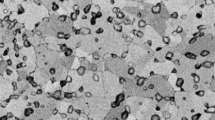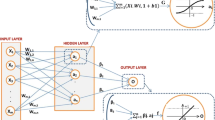Abstract
Accurate creep life prediction is necessary for the evaluation of the remaining creep lives of in-service turbine blades and for the design of new turbine blades in aircraft engines. In this study, an integrated computational material engineering methodology for predicting the remaining creep life of in-service turbine blades was developed by taking a microstructural criterion and creep strain criterion into consideration, and combining artificial neural networks with a modified θ projection model to assess the service temperature, stress, degradation time, and existing creep strain. To explore the application of the method and verify its accuracy, the microstructural degradations at different locations of two directionally solidified superalloy DZ125 turbine blades, which were in-service for 300 h and 980 h in different engines, were characterized and quantified. Using these results, the remaining creep life of the microstructures at different locations of the blade was predicted. Finally, these creep life prediction results were experimentally verified using miniature creep test specimens. The development of this new method provides a reference for the design and service evaluation of turbine blades made of directional solidified and single-crystal Ni-based superalloys.









Similar content being viewed by others
References
Antony KC, Goward GW (1988) Aircraft gas turbine blade and vane repair. In: Superalloys 1988, pp 745–754
AkeKarlsson S, Persson C, Persson PO (1995) Metallographic approach to hirbine blade life time prediction. Adv Manuf Process 10(5):939–953
Larson FR (1952) A time temperature relationship for rupture and creep stress. Trans ASME 74:765–775
Manson SS, Haferd AM (1953) A linear time-temperature relation for extrapolation of creep and stress-rupture data. Technical Note 2890, NACA
Orr RL, Sherby OD, Dorn JE (1953) Correlations of rupture data for metals at elevated temperatures. Institute of Engineering Research, University of California, Berkeley
Manson S, Succop G (1956) Stress-rupture properties of Inconel 700 and correlation on the basis of several time-temperature parameters. In: Symposium on metallic materials for service at temperatures above 1600 F, ASTM International
Wen Z, Hou N, Wang B, Yue Z (2010) Crystallographic life model for single crystal turbine blade and validation by the miniature specimens cut from the turbine blades. Multidiscip Model Mater Struct 6(4):508–529
Dye D, Ma A, Reed RC (2008) Numerical modelling of creep deformation in a CMSX-4 single crystal superalloy turbine blade. In: Superalloys 2008. John Wiley & Sons, Inc., Champion, PA, pp 911–919
Pollock TM, Tin S (2006) Nickel-based superalloys for advanced turbine engines: chemistry, microstructure and properties. J Propul Power 22(2):361–374
Reed RC (2008) The superalloys: fundamentals and applications. Cambridge University Press, Cambridge
Miura N, Kondo Y (2011) Morphology of γ′ precipitates in a first stage low pressure turbine blade of a Ni-based superalloy after service and after following aging. J ASTM Int 9(2):1–9
Miura N, Nakata K, Miyazaki M, Hayashi Y, Kondo Y (2010) Morphology of γ′ precipitates in second stage high pressure turbine blade of single crystal nickel-based superalloy after serviced. Mater Sci Forum 638:2291–2296
Lvov G, Levit V, Kaufman M (2004) Mechanism of primary MC carbide decomposition in Ni-base superalloys. Metall Mater Trans A 35(6):1669–1679
Nathal M, MacKay R (1987) The stability of lamellar γ-γ′ structures. Mater Sci Eng 85:127–138
Qin X, Guo J, Yuan C, Chen C, Hou J, Ye H (2008) Decomposition of primary MC carbide and its effects on the fracture behaviors of a cast Ni-base superalloy. Mater Sci Eng A 485(1–2):74–79
Yuan X, Song J, Zheng Y, Huang Q, Yagi K, Xiao C, Feng Q (2016) Abnormal stress rupture property in K465 superalloy caused by microstructural degradation at 975 °C/225 MPa. J Alloy Compd 662:583–592
Cheng K, Jo C, Jin T, Hu Z (2011) Precipitation behavior of μ phase and creep rupture in single crystal superalloy CMSX-4. J Alloy Compd 509(25):7078–7086
Carter TJ (2005) Common failures in gas turbine blades. Eng Fail Anal 12(2):237–247
Dubiel B, Czyrska-Filemonowicz A (2012) TEM analyses of microstructure evolution in Ex-service single crystal CMSX-4 gas turbine blade. Solid State Phenom 186:139–142
Carroll L, Feng Q, Pollock T (2008) Interfacial dislocation networks and creep in directional coarsened Ru-containing nickel-base single-crystal superalloys. Metall Mater Trans A 39(6):1290–1307
Cassenti B, Staroselsky A (2009) The effect of thickness on the creep response of thin-wall single crystal components. Mater Sci Eng A 508(1–2):183–189
Doner M, Heckler JJS (1988) Identification of mechanisms responsible for degradation in thin-wall stress-rupture properties. In: Superalloys 1988, pp 653–662
Hüttner R, Gabel J, Glatzel U et al (2009) First creep results on thin-walled single-crystal superalloys. Mater Sci Eng A 510:307–311
Chen Y, Zheng Y, Xiao C, Feng Q (2016) Evaluation of temperature and stress in first stage high pressure turbine blades of a directionally-solidified superalloy DZ125 after service in aeroengines. In: Superalloys 2016. John Wiley & Sons, Inc., Hoboken, NJ, pp 701–710
Chen Y, Zheng Y, Feng Q (2016) Evaluating service temperature field of high pressure turbine blades made of directionally solidified Dz125 superalloy based on micro-structural evolution. Acta Metall Sin 52(12):1545–1556
Fu C, Chen Y, Yuan X, Tin S, Antonov S, Yagi K, Feng Q (2019) A modified θ projection model for constant load creep curves-I. Introduction of the model. J Mater Sci Technol 35(1):223–230
Fu C, Chen Y, Yuan X, Tin S, Antonov S, Yagi K, Feng Q (2019) A modified θ projection model for constant load creep curves-II. Application of creep life prediction. J Mater Sci Technol 35(4):687–694
Editorial Board of China Aeronautical Materials Handbook (2005) China aeronautical materials handbook. Standards Press of China, Beijing
Chunhu T (2008) Failure analysis and prevention for rotor in aero-engine. National Defense Industry Press, Beijing
Zhang J, Zheng YR, Feng Q (2016) Study on rejuvenation heat treatment of a directionally-solidified superalloy DZ125 damaged by creep. Acta Metall Sin 52(6):717–726
Chao F, Chen Y, Li L, Antonov S, Feng Q Exploration of quantitative correlation between microstructures and creep property of a directionally-solidified superalloy using ICME method. J Alloys Compd (under revision)
Acknowledgements
The support provided by the National Key Research and Development Program of China (Grant No. 2016YFB0701403), the National Natural Science Foundation of China (Grant No. 51771019 and 51631008) and the 111 Project (No. B170003) is gratefully acknowledged.
Author information
Authors and Affiliations
Corresponding authors
Rights and permissions
About this article
Cite this article
Fu, C., Chen, Y., He, S. et al. ICME Framework for Damage Assessment and Remaining Creep Life Prediction of In-Service Turbine Blades Manufactured with Ni-Based Superalloys. Integr Mater Manuf Innov 8, 509–520 (2019). https://doi.org/10.1007/s40192-019-00161-4
Received:
Accepted:
Published:
Issue Date:
DOI: https://doi.org/10.1007/s40192-019-00161-4




